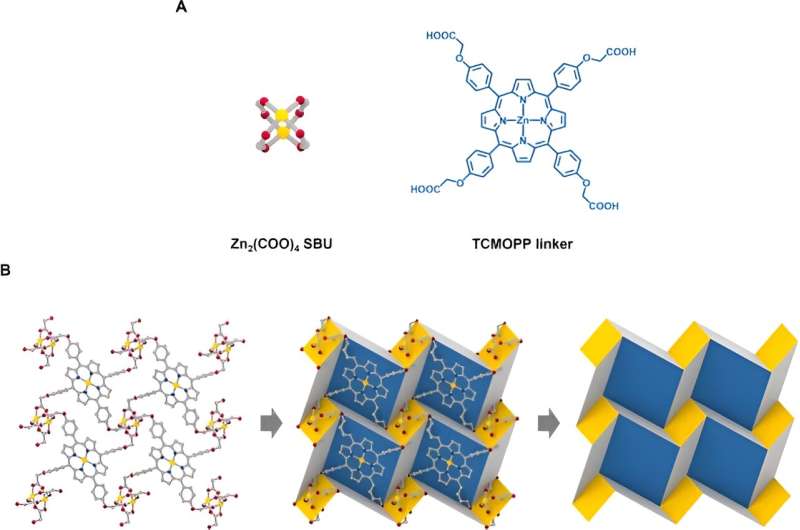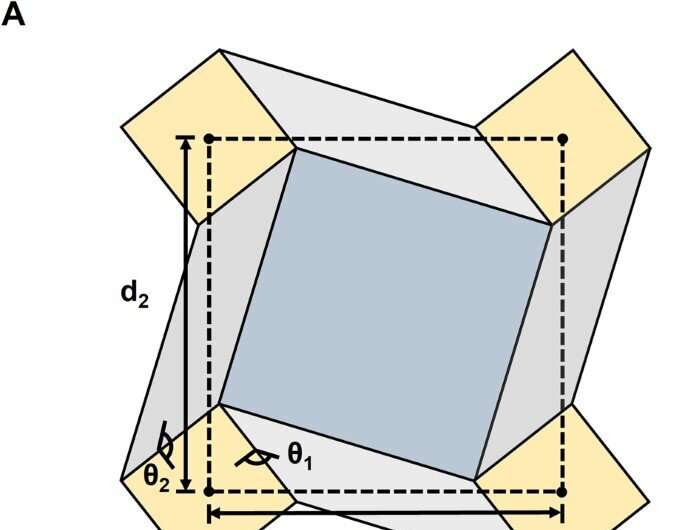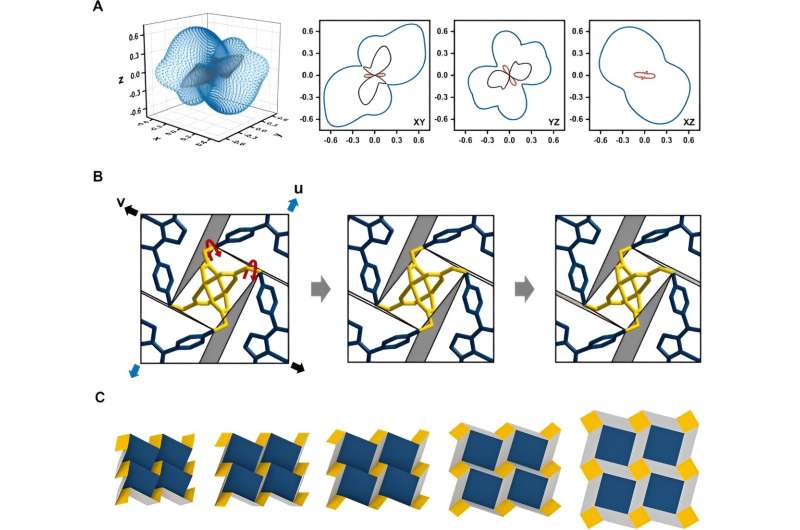December 7, 2023 feature
This article has been reviewed according to Science X's editorial process and policies. Editors have highlighted the following attributes while ensuring the content's credibility:
fact-checked
peer-reviewed publication
trusted source
proofread
Metamaterials and origamic metal-organic frameworks

Origami is a paper folding process usually associated with child's play mostly to form a paper-folded crane, yet it is, as of recently a fascinating research topic. Origami-inspired materials can achieve mechanical properties that are difficult to achieve in conventional materials, and materials scientists are still exploring such constructs based on origami tessellation at the molecular level.
In a new report now published in Nature Communications, Eunji Jin and a research team in chemistry and particle acceleration at the Ulsan National Institute of Science and Technology, Republic of Korea, described the development of a two-dimensional porphyrinic metal-organic framework, self-assembled from zinc nodes and porphyrin linkers based on origami tessellation.
The team combined theory and experimental outcomes to demonstrate origami mechanisms underlying the 2D porphyrinic metal-organic framework with the flexible linker as a pivoting point. The 2D tessellation hidden within the 2D metal-organic framework unveiled origami molecules at the molecular level.
The mathematics and the science of paper folding
The art of paper-folding, also known as origami, now extends beyond that niche to science, engineering, architecture and other industries. The list of origami applications are broadening, as exemplified with solar cells, electronics and biomedical devices. The length scales used for origami have also evolved from the meter to the nanoscale, with close relations to origami tessellations such as Miura-ori, double-corrugation surfaces, Yoshimura and square patterns to name a few. Each origami tessellation contains similar or repeating patterns, although tessellations are highly deployable blueprints to construct mechanical metamaterials with a negative Poisson's ratio; an exotic mechanical property.
Despite the advent of a variety of origami-inspired materials, building molecular materials based on origami tessellations remains a challenge. Materials scientists have shown how it is possible to develop origami-inspired materials using metal-organic frameworks that serve as an ideal platform with unique features that are virtually limitless and exquisitely customizable. Researchers are exploring geometries involving tessellation to uncover the hidden dynamics of metal organic frameworks.
In this new work, Jin and colleagues described metal-organic frameworks based on double corrugation surfaces of origami tessellation that they assembled from a flexible porphyrin linker and a zinc paddlewheel secondary building unit. The thermal movement unveiled in the metal-organic frameworks depended on origami mechanics to show unusual folding behaviors. Such metal-organic frameworks based on origami tessellation can be incorporated as an active emerging class of mechanical metamaterials soon.

Unveiling crystal structures
The research team developed the PPF 301 crystals with a zinc porphyrin component through a solvothermal reaction. These crystals displayed a pale purple color and exhibited a rectangular plate shape. During the experiments, the porphyrin core underwent metallation to develop a five-coordinate zinc ion. The self-assembled 2D layer of PPF-301 showed a corrugated structure with flexible aryloxy groups, where the 2D square structures were built from a tetratopic porphyrinic linker. The team viewed the synchrotron powder X-ray diffraction pattern of the "as synthesized "PPF301 origami-based crystal sample, which matched well with the simulated pattern. Since the double-corrugation surfaces were highly deployable, the PPF301 construct showed origami movement based on flexible nodal points.
The thermal response and origami tessellation of the PPF301 crystal
Jin and team tested a possible structural change in the PPF301 crystals by performing temperature-dependent synchrotron single-crystal X-ray diffraction at an accelerator lab. During the experiments, they prepared a crystal in a sealed capillary with a small amount of solvent added to prevent the loss of crystallinity. The expansion of the crystal interlayers contributed to an increased cell volume, and while changes in the interlayer spacing was present in 2D metal-organic frameworks, the thermal expansion coefficient of the material was significantly higher than that of the many 2D metal-organic frameworks.
Furthermore, the double corrugation surfaces of the material deviated and the team compared the experiment and mechanical model based on origami tessellation. They then pinpointed the origin of origami motion in the metamaterial to the dihedral angle and bond angles of the aryloxy group, which contributed to the 2D origami framework of PPF-301.

Mechanical properties of the origami metamaterial
The research team investigated the mechanical properties of PPF-301 based on origami movement, and performed quantum mechanical calculations to construct an optimized structure, and then calculated the total electronic energies of the construct. Using maximum and minimum values of elastic constraints, they verified the directional contribution of the material. When the team applied mechanical stress, the motion accompanied changes in dihedral angles and bond angles in the aryloxy group.
Previously, materials scientists had examined several flexible metal-organic frameworks that have abnormal properties, including negative linear compressibility and negative Poisson's ratio. However, it is difficult to generate 2D flexible metal-organic frameworks, although the features and properties of the material developed in this study were suited for its behavior in the form of an origami metamaterial.
Outlook
In this way, Eunji Jin and team discovered dynamic crystals that completely changed the general idea of solids as nondynamic concrete entities. The flexible metal-organic frameworks showed remarkable transformation based on abundant molecular building blocks, organic linkers and metal nodes. The scientists accomplished local movements of these building blocks including bending, twisting and rotating behaviors through topology.
They unveiled hidden dynamic behaviors of metal-organic frameworks with flexible geometries. The research team maintained the inherently crumpled pattern of the 2D layer to open a distinct category of metal-organic framework metamaterials with mechanical properties. By regulating the distance between the metal nodes upon external stimuli, they developed advanced molecular quantum computing processes suited for future applications of origami metal organic frameworks.
More information: Eunji Jin et al, Origamic metal-organic framework toward mechanical metamaterial, Nature Communications (2023). DOI: 10.1038/s41467-023-43647-8
Journal information: Nature Communications
© 2023 Science X Network



















